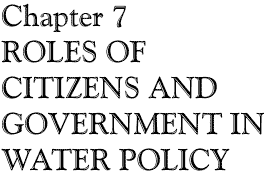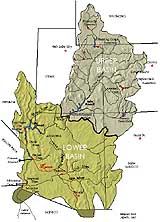
| ch. 7, pp. 97 - 99 |
Southern Arizona Water Rights Settlement Act On October 12, 1982, after agreement was reached by both House and Senate, President Reagan signed into law the Southern Arizona Water Rights Settlement Act (SAWRSA). The act obligated the U.S. Secretary of Interior to deliver 66,000 acre-feet per year to the San Xavier and Schuk Toak districts of the Tohono O’odham Nation. This total is to include 37,800 acre-feet of CAP water and 28,200 acre-feet of wastewater effluent or exchange water, which may be used to exchange for another type of water suitable for agriculture. The tribe has the right to market its negotiated water to users within TAMA or parts of the Upper Santa Cruz Basin not within TAMA. Costs associated with the delivery of CAP water under the sale, exchanges or temporary dispositions are non-reimbursable. The act also established a cooperative fund to pay operations, maintenance and repair charges related to delivery. A schedule was set for delivering water and developing facilities for its use. Meanwhile a dispute arose among the Tohono O’odham Nation, its San Xavier District, and allottees, individual land owners on the San Xavier District. The dispute was the result of developing opposition to dismissing the U.S. v. Tucson lawsuit and to the terms of the SAWRSA settlement. The dispute spawned two additional lawsuits: Alvarez v. Tucson and Adams v. U.S.
Since about 1990, efforts have been made to negotiate an agreement between the allottees, the nation, the federal government and the major defendants to implement SAWRSA and dismiss the lawsuits. Negotiations are ongoing. Meanwhile work which was to be done by the U.S. Bureau of Reclamation to develop the facilities for delivering and using the water on the reservation has been delayed, although construction began in spring of 1999 on a pipeline to take water to the San Xavier District for agricultural purposes. The non-Indian defendants, however, have been more timely in meeting SAWRSA obligations. Tucson and Pima County have contributed effluent, with funding appropriated by the state and non-Indian interests to set up a trust fund. Until U.S. v. Tucson is dismissed, however, SAWRSA is not fully effective. As of yet, no water has been delivered to the Indian people. Arizona’s allocation of Colorado River water is determined by the Law of the River, a collection of legislation, compacts, judicial decisions, international treaties and administrative rules that governs water allocation on the river. The Colorado River Compact of 1922 divided the river into two basins: the Upper and Lower Basins, with the river’s average annual flow divided equally between the basins. Lees Ferry in northern Arizona marks the boundary between the two basins (See Figure 7-7). According to the compact each basin is to receive 7.5 million acre-feet per year. Arizona is a member of the Lower Basin, along with Nevada and California. A division of the waters of the Lower Basin originally was suggested by Congress in the Boulder Canyon Project Act and upheld in the Arizona vs. California Supreme Court decree in 1964. Arizona was allotted 2.8 million acre-feet of Colorado River water, California was allotted 4.4 million acre-feet, and 300,000 acre-feet was alloca ted to Nevada. Along with its Lower Basin allocation, Arizona also gets 50,000 acre-feet of Upper Basin water. Approximately 1.3 million acre-feet of Arizona’s allocation of Colorado River water is consumed along the mainstem of the river, mainly for agricultural purposes. This leaves an average of 1.5 million acre-feet per year to be carried to central Arizona via the CAP canal. The canal has a design capacity for delivery of 2.1 million acre-feet per year, which is reduced to approximately 1.9 million acre-feet per year due to the need for routine maintenance. This extra capacity allows Arizona to take water above its annual allocation if a surplus is declared on the river. CAP deliveries may be interrupted by drought shortages on the river or by the need to repair and maintain the canal. To gain the support of California’s delegation for Congressional approval of the CAP, Arizona was forced to agree that, in times of shortage, California’s full 4.4 million acre-feet will be delivered before any water will be provided to the CAP. As a result, any shortages in the Lower Basin will be borne first by the CAP. The risk of drought shortage is projected to increase over time. After the year 2025, the probability of shortages affecting CAP water users is anticipated to reach approximately 30 percent. The probability that municipal and industrial users will be affected is approximately 5 percent. The law assigns the highest priorities for delivery of subcontracted CAP water to Indian and municipal and industrial (M&I) subcontractors. The lowest priority is assigned to non-Indian agriculture. This means if scheduled deliveries must be curtailed in any year, deliveries to non-Indian agricultural subcontractors will be cut first. The amount of water delivered over the year is set, but the amount delivered each day varies greatly over the year, depending on demand. At times of high demand municipal users get first priority, but only for direct delivery. Municipal recharge projects have a lower priority than agriculture. In March 1997, delivery to recharge sites was halted temporarily to meet demands for direct municipal use and agriculture. This reversal of the priority system that normally places agriculture last may require recharge systems be designed to accept larger amounts of water at times when deliveries are high to compensate for the times when deliveries are cut. Possible changes to this policy are being discussed.
|

